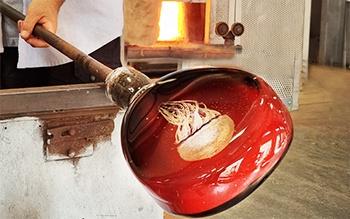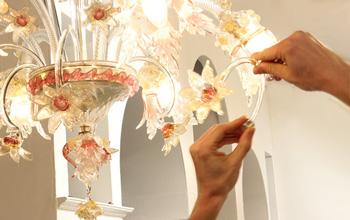Let's start right from the beginning ... Some (quick) mention of the chemical composition of borosilicate
Borosilicate lampworking can be considered the other great branch of the lampworking in Murano Island, along with the most diffused one based on Murano Glass. The difference between the two types of glass, and thus between the two processing techniques and between the two artistic offers of the final product, is based obviously on the chemical composition: Murano Glass belongs to the sodium-calcium group, borosilicate - as it is conceivable - to the boron glass group.
The latter is a glass type of modern era, and was made in Germany by the chemist Otto Schott between 1887 and 1893, when it was actually patented under the name "Duran".
Its composition results a substantial amount of boron and only a minimum amount of soda, a composition which, given the function of the melting element and the mobile nature of the soda, gives this type of glass to one side more heat resistance and, on the other, greater stability once the machining process has ended.
How was borosilicate used yesterday? And today?
The first use of borosilicate glass was therefore in the chemical-pharmaceutical sector (test tubes, cylinders, amphibians) and in the food one (glasses, pots, and bottles), given the more developed ability to withstand acidic or aggressive surfaces. The subsequent creation of the American brand Pirex and the opening of American factories in France made it possible that from the 1920s onwards in these two countries the processing and use of this material became more widespread and open to experimental results.
Only later, borosilicate began to be used in the field of art, and more recently, from the early 1980s, it was able to find its own space within Murano's working practice.
Murano Glass VS Borosilicate: when boron is disadvantageous and when it isn’t
Still considered as a sophisticated and niche alternative to the island's lampworkers, the use of borosilicate glass has some disadvantages and some strengths compared to that of sodium-calcium glass.
- Due to the lower expansion coefficient (33 compared to 104 of "Murano glass"), borosilicate needs higher temperatures to reach the melting point and therefore to be in the conditions of work, which involves the use of burners (in jargon cannelli) more powerful, and therefore a greater consumption of gas and oxygen and higher costs.
- In addition, due to the highest melting point, some (very few) elements such as silver and the oxide specific for transparent clear blue color are incompatible. Therefore, it is not possible to cover that particular color range because the necessary elements would melt before the glass itself, making it impossible to properly amalgamate with the base material.
In spite of these deficits, borosilicate glass has several positive properties compared to the most common sodium-calcium.
- Greater brightness
- Greater hardness
- More stress-resistant
This latter peculiarity allows the craftsman or artist who uses borosilicate to embark into boldest aesthetic evolutions, counting on the possibility of making larger objects and experimenting more courageous forms.
Particularly easy is the connection between empty and full sections (such as, for example, a bowl and a stem of a chalice), a condition that induces borosilicate lampworking Masters to deepen the blowing technique of glass compared to that of full glass: here because are most frequent light and sinuous works, more directed to the delicacy of curved and concave shapes than to the compactness of massive bodies.
The wisdom of the Masters of Murano
A double possibility, therefore, of sodium-calcium and borosilicate glasses, an element of wealth for Murano glass art and for lampworking technique in particular.
But more than a real clash, more than a true competition between two factions, some lampworking masters summarize the matter with a maxim as simple as effective: "For every aesthetic project and every work, the right kind of glass". And how can we give them wrong?











